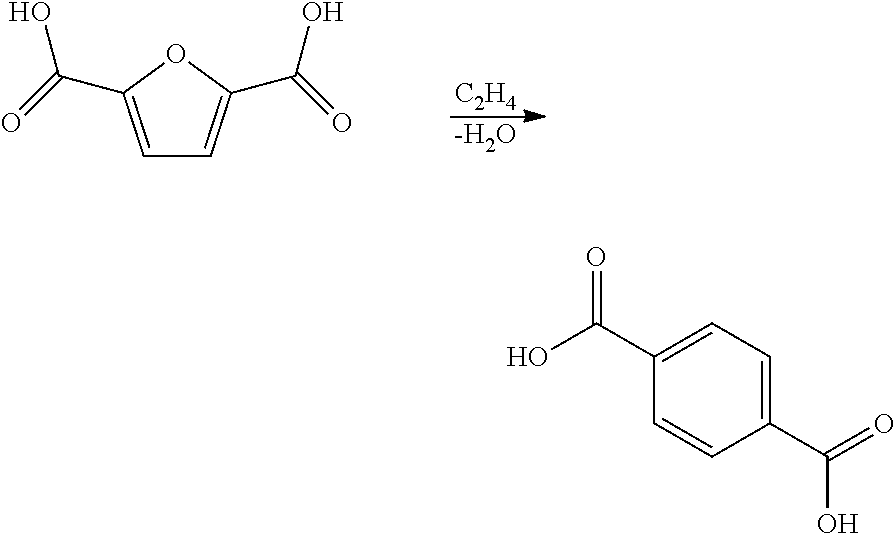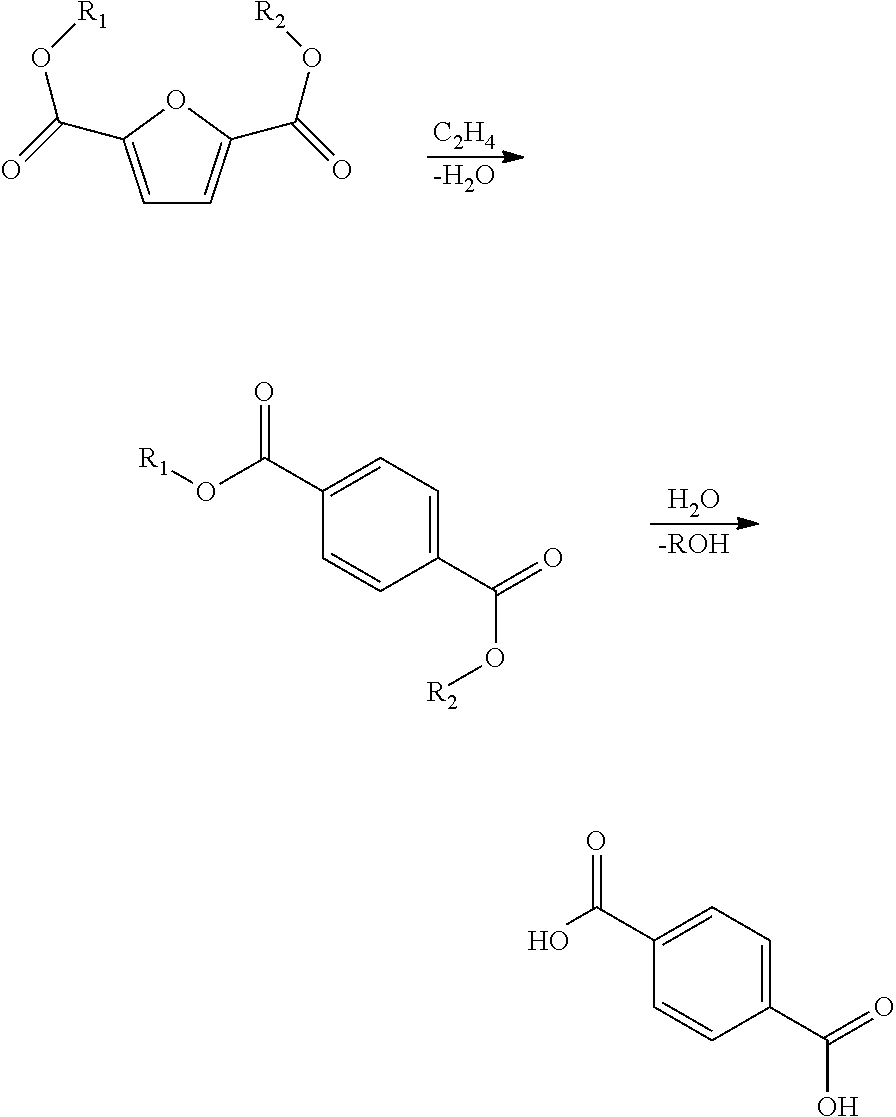Processes and catalysts for conversion of 2,5-dimethylfuran derivatives to terephthalate
a technology of dimethylfuran and catalyst, which is applied in the direction of carboxylic acid esters/lactone preparations, chemistry apparatus and processes, and para-xylene oxidation to pta, etc., can solve the problems of inefficient atom-efficient approaches, inability to generate px from biomass as a feedstock for pta, and high capital expenditur
- Summary
- Abstract
- Description
- Claims
- Application Information
AI Technical Summary
Benefits of technology
Problems solved by technology
Method used
Image
Examples
example 1
[0056]In this example, 1 g FDCA was the feed, the solvent was butanol, and 2 g of catalyst was used. Two different catalysts were used in separate reactions: 1) either Norit® CA1 activated carbon (available from Sigma-Aldrich) which had been washed 3 times with 10 wt % nitric acid or 2) steamed HY zeolite with Si / Al elemental mole ratio of 2.57 (SiO2 / Al2O3 ratio of 5.14). The reaction pressure during the reaction using activated carbon catalyst was 9.2 MPa (g) (91 atm), and it was 8.6 MPa (g) (85 atm) using the HY zeolite. The reaction temperature was 225° C., and the reaction time after reaching temperature was 5 hours. Under these conditions, FDCA is expected to undergo esterification reaction to form dibutyl-FDCA. GC-MS showed conversion of FDCA to the di-butyl ester derivative of FDCA and the butyl-ester derivative of FDCA using either catalyst, as well as a trace amount of dibutyl-terephthalate in the reaction using the HY zeolite. The products in these reactions also contained...
example 2
[0060]In this example 0.57 g DM-FDCA was the feed. Steamed HY zeolite with Si / Al elemental mole ratio of 2.57 was used as the catalyst and was dried at 150° C. for 3 hours and calcined at 500° C. for 6 hours prior to reaction. The pre-calcination weight was 2 grams (for comparison to example 1), but the post-calcination weight was 1.58 g. n-Heptane was loaded as the solvent. The reaction pressure was 9.1-9.2 MPa (g) (90-91 atm), and the temperature was 225-226° C. The reaction was held at temperature for 5.5 hours. The result was an orange-brown solid (spent catalyst and coke) and a clear liquid. Products, analyzed by GC, are shown in Table 1 (as mol % of initial moles DM-FDCA added). Furans conversion was 83.0%. The total yield of terephthalates was 3.4%, and terephthalate selectivity was 4.1%. The mass balance of furans+terephthalates was 20.4%. In the total furan and terephthalate products 63% of the esters were ethyl esters (the remaining portion were methyl esters). Coke yield ...
example 3
[0061]In this example 0.59 g DM-FDCA (obtained commercially) was the feed. The material used here as catalyst used here is described in example 7 of U.S. Pat. No. 6,380,428, with an additional drying and reduction treatment. It was silver-exchanged LZ-210 Y-zeolite (described in U.S. Pat. No. 4,503,023) oil-dropped spheres that contained 20% silica binder and 80% zeolite, where the zeolite component had SiO2 / Al2O3 mol ratio of 10. That material was dried at 300° C. for 2 hours and reduced at 250° C. in hydrogen for 2 hours prior to reaction. The catalyst was 9.34% silver (by weight, dry basis). n-Heptane was loaded as the solvent, along with 1.59 g of dried reduced catalyst. The reaction pressure was 9.9-10.1 MPa (g) (98-100 atm), and the temperature was 224-226° C. The reaction was held at temperature for 5.5 hours. The result was an orange-brown solid (spent catalyst and coke) and a clear liquid. Products, analyzed by GC, are shown in Table 1 (as mol % of initial moles DM-FDCA add...
PUM
| Property | Measurement | Unit |
|---|---|---|
| Temperature | aaaaa | aaaaa |
| Temperature | aaaaa | aaaaa |
| Pressure | aaaaa | aaaaa |
Abstract
Description
Claims
Application Information
 Login to View More
Login to View More - R&D
- Intellectual Property
- Life Sciences
- Materials
- Tech Scout
- Unparalleled Data Quality
- Higher Quality Content
- 60% Fewer Hallucinations
Browse by: Latest US Patents, China's latest patents, Technical Efficacy Thesaurus, Application Domain, Technology Topic, Popular Technical Reports.
© 2025 PatSnap. All rights reserved.Legal|Privacy policy|Modern Slavery Act Transparency Statement|Sitemap|About US| Contact US: help@patsnap.com



